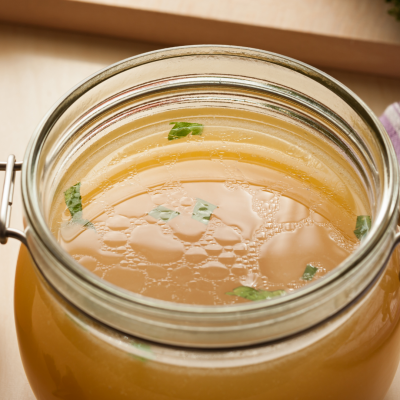
Revealing the Benefits of Bone Broth For Gut Health
Aside from being the best kept secret for flavorful cooking, bone broth is incredibly nutritious and offers several health benefits for your gut. Bone broth is super easy to make and is a great addition to your gut-health arsenal!
The bones and cartilage of animals and fish contain an abundance of minerals, peptides, and amino acids which can play an important role in gut health.
Let’s review some here.
Minerals
Bone broth contains some important minerals including:
- Calcium
- Magnesium
- Copper
- Iron
- Manganese
- Phosphorus
- Potassium
- Sodium
- Zinc
Zinc is an essential nutrient in the gut barrier function ensuring that the intestinal wall is strong. It can also protect from chemically-induced stomach ulcers. It also supports our ability to digest food by ensuring we secrete adequate stomach acid.
A magnesium rich diet may contribute to greater diversity in gut microbes and reduce anxiety levels via the gut-brain-axis.
Bone broth is also full of electrolytes (like sodium, potassium, magnesium, and calcium) which can be especially important to replete for those experiencing chronic diarrhea.
Adding a splash of vinegar to your bone broth is reported to help better extract these minerals from bone. My personal opinion is that the length of time bones are cooked is equally important for the mineral extraction process to occur.
Peptides & Amino Acids
Several peptides and amino acids that are present in bone broth are healing for the digestive tract. Let’s go over a few of them here.
Collagen
Collagen plays an important role in developing and regulating tissue within the body–meaning that collagen can help repair tissue in the G.I. (gastrointestinal) tract damaged from inflammation.
Gelatin
Gelatin can soothe an inflamed gut lining and ease symptoms of IBS (irritable bowel syndrome), IBD (irritable bowel disease), and even acid reflux. Also, gelatin promotes the growth of good gut bacteria, helping to re-balance our gut favorably.
Glutamine
Glutamine, in particular, helps heal the intestinal barrier. This is beneficial for those experiencing leaky gut which can irritate the mucus lining of the intestines. Leaky gut can eventually lead to food sensitivities, skin issues, digestive issues, and even autoimmune conditions.
Glutamine is literally the fuel for our intestinal cells and it can be incredibly beneficial for healing the gut lining in general. It’s been shown to also be helpful for those suffering from IBS and IBD.
Glycine
Glycine, in particular, has been shown to protect the mucus layer of the stomach lining from chemical and stress-induced stomach ulcers. It also reduces intestinal injury during active infections from bad bacteria in the gut.
Glycine can stimulate stomach secretions and helps to make bile acids, therefore enhancing the breakdown and digestibility of foods. Since it contributes to the synthesis of bile salts, it effectively enhances our absorption of fat soluble vitamins like A, D, E, and K and improves our ability to digest fats.
Glycoaminoglycans (GAGs)
Finally, glycoaminoglycans (GAGs) can diminish the severity of IBD by reducing inflammation, oxidative stress, and pro-inflammatory cytokines.
Real Food For the Win
The point of me listing this all out for you is to show you that the combination of all of these beneficial minerals, peptides, and amino acids is where the beauty of bone broth lies.
When we eat the foods rich in the very nutrients our body needs to repair, regenerate, seal & heal, and re-balance we’re harnessing a true super power: eating real food.
Are the benefits of bone broth bought from your local grocery store the same?
I’d argue they’re not.
Why?
Home cooked bone broth:
- Starts with quality ingredients (i.e. locally raised or free range organic chicken, organic produce & spices)
- Avoids unnecessary chemical additives (i.e. MSG, extracts, natural flavors, etc)
- Doesn’t contain ingredients that are sensitive foods for you (i.e. gluten, corn, yeast, etc)
- Are cooked longer, and therefore extract more beneficial nutrients
In short, making your own bone broth will bring much more nutritional benefit than opting for store bought versions (and it also gives you a sense of satisfaction and empowerment knowing you made it all on your own!).
Chicken Bone Broth Recipe.
It’s super important to seek quality animal products for this process. I recommend locally raised or organic and pasture raised animal products for this recipe.
I hope you’ll make this bone broth recipe part of your gut healing routine!

Chicken Bone Broth Recipe
Equipment
- Cutting Board
- Knife
- Roasting pan
- Large Soup Pot
- 8-10 Mason Jars
- Small Strainer that fits over top of Mason Jars
Ingredients
- 1 whole organic pasture raised chicken
- 2 tbsp grass fed ghee, butter, olive oil or avocado oil
- 2-3 tsp sea salt
- 2 tsp black pepper
- 1 whole red or yellow onion with skin, quartered
- 3 whole carrots, unpeeled, roughly chopped
- 4 ribs celery with leaves, roughly chopped
- 3 cloves garlic, crushed
- 2 whole bay leaves
- 1-2 cups additional vegetable scraps such as kale stems, parsley, ginger, carrot tops, vegetable peels, etc.
- 2 tbsp raw apple cider vinegar or distilled vinegar
- 2 tbsp turmeric
- filtered water to fill stock pot
Instructions
- Turn oven on to 350 F
- Coat the inside and outside of the chicken with ghee or butter (or olive oil or avocado oil if you're dairy sensitive), 1 tsp sea salt and 1 tsp black pepper.
- Roast chicken in oven for 1.5 hours (roast for about 20 minutes per pound). Chicken internal temp should reach 165 F with thermometer inserted into thickest part of thigh (not touching bone).
- Eat chicken as you normally would for main course meal or use shredded chicken for chicken salad, chicken and rice soup, etc.
- Put the entire chicken carcass (bones + connective tissue) into a large soup pot
- Add vegetables and scraps to pot
- Fill soup pot to top with filtered water, covering bones and veggies
- Add turmeric, bay leaf, apple cider vinegar, and 1-2 tsp sea salt, 1 tsp black pepper (optional)
- Let soup simmer on stovetop with lid on for 24 hours (you may need to add more filtered water as you go if it burns off).
- Within 2 hours of cooling, strain stock into clean mason jars– leaving a few inches of space at the top.
- Freeze for up to 6 months (sometimes longer). When you thaw your broth make sure to use it within a few days.
- Use in any of your favorite soup recipes or drink it heated up in a coffee mug!
Notes
Here’s the Best Part: I’ve Got Your Back in Finding Your Way to True Vitality
No more guessing games, no more randomly eliminating foods and hoping for a miracle.
I’m here to help you design a clear, customized path to wellness that’s built specifically for your body. We’ll pinpoint the exact foods causing your gut issues, then work together to create a plan that heals and restores balance. This isn’t a one-size-fits-all approach—it’s a solution tailored to you.
Ready to uncover the true cause of your gut inflammation and start your transformational gut healing journey? My program is custom-built and reserved only for those who’re ready to go all in. Schedule your digestive assessment with me to get started.
References:
https://www.ncbi.nlm.nih.gov/pmc/articles/PMC4231515/
https://www.ncbi.nlm.nih.gov/pmc/articles/PMC6024889/
https://www.ncbi.nlm.nih.gov/pubmed/20089787
https://www.ncbi.nlm.nih.gov/pmc/articles/PMC3358810/
https://www.ncbi.nlm.nih.gov/pmc/articles/PMC4040816/
https://www.ncbi.nlm.nih.gov/pubmed/27749689
https://gut.bmj.com/content/68/6/996
https://www.ncbi.nlm.nih.gov/pmc/articles/PMC5622680/
https://link.springer.com/article/10.1007/s00726-014-1773-4
https://www.ncbi.nlm.nih.gov/pubmed/25012270
https://www.ncbi.nlm.nih.gov/pubmed/7065145
https://europepmc.org/abstract/med/9344231
https://www.ncbi.nlm.nih.gov/pubmed/11121904
https://www.ncbi.nlm.nih.gov/pubmed/14600124
https://www.mdpi.com/1648-9144/57/11/1138
https://www.medicalnewstoday.com/articles/bone-broth-for-ibs#benefits

